Zoo
A zoo (short for zoological garden; also called an animal park or menagerie) is a facility in which animals are housed within enclosures, cared for, displayed to the public, and in some cases bred.
The term "zoological garden" refers to zoology, the study of animals. The term is derived from the Greek ζώον, 'zoon', "animal," and the suffix -λογία, '-logia', "study of". The abbreviation "zoo" was first used of the London Zoological Gardens, which was opened for scientific study in 1828 and to the public in 1847.[1] In the United States alone, zoos are visited by over 181 million people annually.[2]
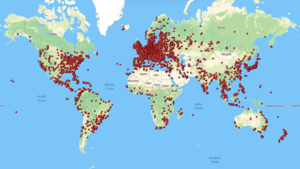
Etymology

The London Zoo, which was opened in 1828, was initially known as the "Gardens and Menagerie of the Zoological Society of London", and it described itself as a menagerie or "zoological forest".[3] The abbreviation "zoo" first appeared in print in the United Kingdom around 1847, when it was used for the Clifton Zoo, but it was not until some 20 years later that the shortened form became popular in the song "Walking in the Zoo" by music-hall artist Alfred Vance.[3] The term "zoological park" was used for more expansive facilities in Halifax, Nova Scotia, Washington, D.C., and the Bronx in New York, which opened in 1847, 1891 and 1899 respectively.[4]
Relatively new terms for zoos in the late 20th century are "conservation park" or "bio park". Adopting a new name is a strategy used by some zoo professionals to distance their institutions from the stereotypical and nowadays criticized zoo concept of the 19th century.[5] The term "bio park" was first coined and developed by the National Zoo in Washington D.C. in the late 1980s.[6] In 1993, the New York Zoological Society changed its name to the Wildlife Conservation Society and re branded the zoos under its jurisdiction as "wildlife conservation parks".[7]
History
Royal menageries
The predecessor of the zoological garden is the menagerie, which has a long history from the ancient world to modern times. The oldest known zoological collection was revealed during excavations at Hierakonpolis, Egypt in 2009, of a ca. 3500 BCE menagerie. The exotic animals included hippopotami, hartebeest, elephants, baboons and wildcats.[8] King Ashur-bel-kala of the Middle Assyrian Empire created zoological and botanical gardens in the 11th century BCE. In the 2nd century BCE, the Chinese Empress Tanki had a "house of deer" built, and King Wen of Zhou kept a 1,500-acre (6.1 km2) zoo called Ling-Yu, or the Garden of Intelligence. Other well-known collectors of animals included King Solomon of the Kingdom of Israel and Judah, queen Semiramis and King Ashurbanipal of Assyria, and King Nebuchadnezzar of Babylonia.[9] By the 4th century BCE, zoos existed in most of the Greek city states; Alexander the Great is known to have sent animals that he found on his military expeditions back to Greece. The Roman emperors kept private collections of animals for study or for use in the arena,[9] the latter faring notoriously poorly. The 19th-century historian W. E. H. Lecky wrote of the Roman games, first held in 366 BCE:
At one time, bear and a bull, chained together, rolled in fierce combat across the sand ... Four hundred bears were killed in a single day under Caligula ... Under Nero, four hundred tigers fought with bulls and elephants. In a single day, at the dedication of the Colosseum by Titus, five thousand animals perished. Under Trajan ... lions, tigers, elephants, rhinoceroses, hippopotami, giraffes, bulls, stags, even crocodiles and serpents were employed to give novelty to the spectacle.[10]
Charlemagne had an elephant named Abul-Abbas that was given to him by the Abbasid Caliph. Henry I of England kept a collection of animals at his palace in Woodstock which reportedly included lions, leopards, and camels.[11] The most prominent collection in medieval England was in the Tower of London, created as early as 1204 by King John I.
Henry III received a wedding gift in 1235 of three leopards from Frederick II, Holy Roman Emperor, and in 1264, the animals were moved to the Bulwark, renamed the Lion Tower, near the main western entrance of the Tower. It was opened to the public during the reign of Elizabeth I in the 16th century.[12] During the 18th century, the price of admission was three half-pence, or the supply of a cat or dog for feeding to the lions.[11] The animals were moved to the London Zoo when it opened.
Aztec emperor Moctezuma had in his capital city of Tenochtitlan a "house of animals" with a large collection of birds, mammals and reptiles in a garden tended by more than 600 employees. The garden was described by several Spanish conquerors, including Hernán Cortés in 1520. After the Aztec revolt against the Spanish rule, and during the subsequent battle for the city, Cortés reluctantly ordered the zoo to be destroyed.[13]
Enlightenment Era
The oldest zoo in the world still in existence is the Tiergarten Schönbrunn in Vienna, Austria. It was constructed by Adrian van Stekhoven in 1752 at the order of the Holy Roman Emperor Francis I, husband of Maria Theresa of Austria, to serve as an imperial menagerie as part of Schönbrunn Palace. The menagerie was initially reserved for the viewing pleasure of the imperial family and the court, but was made accessible to the public in 1765.
In 1775, a zoo was founded in Madrid, and in 1795, the zoo inside the Jardin des Plantes in Paris was founded by Jacques-Henri Bernardin, with animals from the royal menagerie at Versailles, primarily for scientific research and education. The Kazan Zoo, the first zoo in Russia was founded in 1806 by the Professor of Kazan State University Karl Fuchs.
The modern zoo
Until the early 19th century, the function of the zoo was often to symbolize royal power, like King Louis XIV's menagerie at Versailles. The modern zoo that emerged in the 19th century in the United Kingdom,[14] was focused on providing scientific study and later educational exhibits to the public for entertainment and inspiration.[15]
A growing fascination for natural history and zoology, coupled with the tremendous expansion in the urbanization of London, led to a heightened demand for a greater variety of public forms of entertainment to be made available. The need for public entertainment, as well as the requirements of scholarly research, came together in the founding of the first modern zoos.
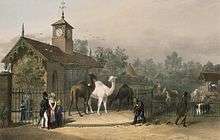
The Zoological Society of London was founded in 1826 by Stamford Raffles and established the London Zoo in Regent's Park two years later in 1828.[16] At its founding, it was the world's first scientific zoo.[9][17] Originally intended to be used as a collection for scientific study, it was opened to the public in 1847.[17] The Zoo was located in Regent's Park - then undergoing development at the hands of the architect John Nash. What set the London zoo apart from its predecessors was its focus on society at large. The zoo was established in the middle of a city for the public, and its layout was designed to cater for the large London population. The London zoo was widely copied as the archetype of the public city zoo.[18] In 1853, the Zoo opened the world's first public aquarium.
Dublin Zoo was opened in 1831 by members of the medical profession interested in studying animals while they were alive and more particularly getting hold of them when they were dead.[19]
Downs' Zoological Gardens created by Andrew Downs and opened to the Nova Scotia public in 1847. It was originally intended to be used as a collection for scientific study. By the early 1860s, the zoo grounds covered 40 hectares with many fine flowers and ornamental trees, picnic areas, statues, walking paths, The Glass House (which contained a greenhouse with an aviary, aquarium, and museum of stuffed animals and birds), a pond, a bridge over a waterfall, an artificial lake with a fountain, a wood-ornamented greenhouse, a forest area, and enclosures and buildings.[20][21][22]
The first zoological garden in Australia was Melbourne Zoo in 1860. In the same year, Central Park Zoo, the first public zoo in the United States, opened in New York, although in 1859, the Philadelphia Zoological Society had made an effort to establish a zoo, but delayed opening it until 1874 because of the American Civil War.
In 1907, the German entrepreneur Carl Hagenbeck founded the Tierpark Hagenbeck in Stellingen, now a quarter of Hamburg. His zoo was a radical departure from the layout of the zoo that had been established in 1828. It was the first zoo to use open enclosures surrounded by moats, rather than barred cages, to better approximate animals' natural environments.[23] He also set up mixed-species exhibits and based the layout on the different organizing principle of geography, as opposed to taxonomy.
Whipsnade Park Zoo in Bedfordshire, England, opened in 1931. It allowed visitors to drive through the enclosures and come into close proximity with the animals.
When ecology emerged as a matter of public interest in the 1970s, a few zoos began to consider making conservation their central role, with Gerald Durrell of the Jersey Zoo, George Rabb of Brookfield Zoo, and William Conway of the Bronx Zoo (Wildlife Conservation Society) leading the discussion. From then on, zoo professionals became increasingly aware of the need to engage themselves in conservation programs, and the American Zoo Association soon said that conservation was its highest priority.[24] In order to stress conservation issues, many large zoos stopped the practice of having animals perform tricks for visitors. The Detroit Zoo, for example, stopped its elephant show in 1969, and its chimpanzee show in 1983, acknowledging that the trainers had probably abused the animals to get them to perform.[25]
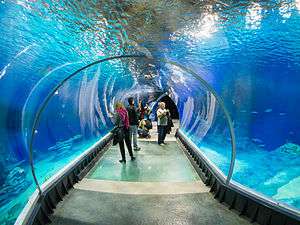
The Wrocław Zoo (Polish: Ogród Zoologiczny we Wrocławiu), the oldest zoo in Poland opened in 1865 and was home to about 10,500 animals representing about 1,132 species (in terms of the number of animal species it is the third largest in the world[26]). In 2014 the Wrocław Zoo opened the Africarium, the only themed oceanarium devoted solely to exhibiting the fauna of Africa, comprehensively presenting selected ecosystems from the continent of Africa. Housing over 10 thousand animals, the facility's breadth extends from housing insects such cockroaches to the large mammals like the elephants on an area of over 33 hectares.[27]
Mass destruction of wildlife habitat has yet to cease all over the world and many species such as elephants, big cats, penguins, tropical birds, primates, rhinos, exotic reptiles, and many others are in danger of dying out. Many of today's zoos hope to stop or slow the decline of many endangered species and see their primary purpose as breeding endangered species in captivity and reintroducing them into the wild. Modern zoos also aim to help teach visitors the importance on animal conservation, often through letting visitors witness the animals firsthand.[28] Some critics and the majority of animal rights activists say that zoos, no matter what their intentions are, or how noble they are, are immoral and serve as nothing but to fulfill human leisure at the expense of the animals (which is an opinion that has spread over the years). However, zoo advocates argue that their efforts make a difference in wildlife conservation and education.[28]
Human exhibits
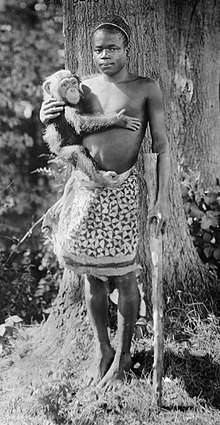
Human beings were sometimes displayed in cages along with non-human animals, to illustrate the differences between people of European and non-European origin. In September 1906, William Hornaday, director of the Bronx Zoo in New York—with the agreement of Madison Grant, head of the New York Zoological Society—had Ota Benga, a Congolese pygmy, displayed in a cage with the chimpanzees, then with an orangutan named Dohong, and a parrot. The exhibit was intended as an example of the "missing link" between the orangutan and white man. It triggered protests from the city's clergymen, but the public reportedly flocked to see Benga.[29][30]
Human beings were also displayed in cages during the 1931 Paris Colonial Exposition, and as late as 1958 in a "Congolese village" display at Expo '58 in Brussels.[31]
Type
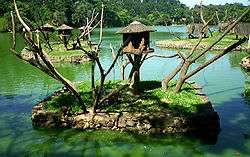
Zoo animals live in enclosures that often attempt to replicate their natural habitats or behavioral patterns, for the benefit of both the animals and visitors. Nocturnal animals are often housed in buildings with a reversed light-dark cycle, i.e. only dim white or red lights are on during the day so the animals are active during visitor hours, and brighter lights on at night when the animals sleep. Special climate conditions may be created for animals living in extreme environments, such as penguins. Special enclosures for birds, mammals, insects, reptiles, fish, and other aquatic life forms have also been developed. Some zoos have walk-through exhibits where visitors enter enclosures of non-aggressive species, such as lemurs, marmosets, birds, lizards, and turtles. Visitors are asked to keep to paths and avoid showing or eating foods that the animals might snatch.
Safari park
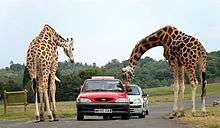
Some zoos keep animals in larger, outdoor enclosures, confining them with moats and fences, rather than in cages. Safari parks, also known as zoo parks and lion farms, allow visitors to drive through them and come in close proximity to the animals.[9] Sometimes, visitors are able to feed animals through the car windows. The first safari park was Whipsnade Park in Bedfordshire, England, opened by the Zoological Society of London in 1931 which today (2014) covers 600 acres (2.4 km²). Since the early 1970s, an 1,800 acre (7 km²) park in the San Pasqual Valley near San Diego has featured the San Diego Zoo Safari Park, run by the Zoological Society of San Diego. One of two state-supported zoo parks in North Carolina is the 2,000-acre (8.1 km2) North Carolina Zoo in Asheboro.[32] The 500-acre (2.0 km2) Werribee Open Range Zoo in Melbourne, Australia, displays animals living in an artificial savannah.
Aquaria
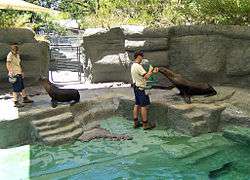
The first public aquarium was opened at the London Zoo in 1853. This was followed by the opening of public aquaria in continental Europe (e.g. Paris in 1859, Hamburg in 1864, Berlin in 1869, and Brighton in 1872) and the United States (e.g. Boston in 1859, Washington in 1873, San Francisco Woodward's Garden in 1873, and the New York Aquarium at Battery Park in 1896).
Roadside zoos
Roadside zoos are found throughout North America, particularly in remote locations. They are often small, for-profit zoos, often intended to attract visitors to some other facility, such as a gas station. The animals may be trained to perform tricks, and visitors are able to get closer to them than in larger zoos.[33] Since they are sometimes less regulated, roadside zoos are often subject to accusations of neglect[34] and cruelty.[35]
In June 2014 the Animal Legal Defense Fund filed a lawsuit against the Iowa-based roadside Cricket Hollow Zoo for violating the Endangered Species Act by failing to provide proper care for its animals.[36] Since filing the lawsuit, ALDF has obtained records from investigations conducted by the USDA's Animal and Plant Health Inspection Services; these records show that the zoo is also violating the Animal Welfare Act.[37]
Petting zoos
A petting zoo, also called petting farms or children's zoos, features a combination of domestic animals and wild species that are docile enough to touch and feed. To ensure the animals' health, the food is supplied by the zoo, either from vending machines or a kiosk nearby.
Animal theme parks
An animal theme park is a combination of an amusement park and a zoo, mainly for entertaining and commercial purposes. Marine mammal parks such as Sea World and Marineland are more elaborate dolphinariums keeping whales, and containing additional entertainment attractions. Another kind of animal theme park contains more entertainment and amusement elements than the classical zoo, such as a stage shows, roller coasters, and mythical creatures. Some examples are Busch Gardens Tampa Bay in Tampa, Florida, both Disney's Animal Kingdom and Gatorland in Orlando, Florida, Flamingo Land in North Yorkshire, England, and Six Flags Discovery Kingdom in Vallejo, California.
Sources of animals
By the year 2000 most animals being displayed in zoos were the offspring of other zoo animals. This trend, however was and still is somewhat species-specific. When animals are transferred between zoos, they usually spend time in quarantine, and are given time to acclimatize to their new enclosures which are often designed to mimic their natural environment. For example, some species of penguins may require refrigerated enclosures. Guidelines on necessary care for such animals is published in the International Zoo Yearbook.[38]
Justification
Conservation and research
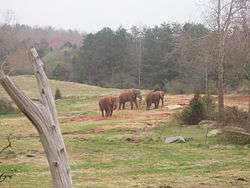
The position of most modern zoos in Australasia, Asia, Europe, and North America, particularly those with scientific societies, is that they display wild animals primarily for the conservation of endangered species, as well as for research purposes and education, and secondarily for the entertainment of visitors,[39][40] an argument disputed by critics. The Zoological Society of London states in its charter that its aim is "the advancement of Zoology and Animal Physiology and the introduction of new and curious subjects of the Animal Kingdom." It maintains two research institutes, the Nuffield Institute of Comparative Medicine and the Wellcome Institute of Comparative Physiology. In the U.S., the Penrose Research Laboratory of the Philadelphia Zoo focuses on the study of comparative pathology.[9] The World Association of Zoos and Aquariums produced its first conservation strategy in 1993, and in November 2004, it adopted a new strategy that sets out the aims and mission of zoological gardens of the 21st century.[41]
Conservation programs all over the world fight to protect species from going extinct, but the unfortunate reality is, most conservation programs are underfunded and underrepresented. Conservation programs can struggle to fight bigger issues like habitat loss and illness. To rebuild degrading habitats takes major funding and a massive amount of time, both of which are scarce in conservation efforts. The current state of conservation programs cannot rely solely on situ (onsite conservation) plans alone, ex-situ (off-site conservation) is often needed. Off-site conservation relies on zoos, national parks, or other care facilities to support the rehabilitation of the animals and their populations. Zoos benefit conservation by providing suitable habitats and care to endangered animals. When properly regulated, they present a safe, clean environment for the animals to diversely repopulate. A study on amphibian conservation and zoos addressed these problems by writing,
Whilst addressing in situ threats, particularly habitat loss, degradation and fragmentation, is of primary importance; for many amphibian species in situ conservation alone will not be enough, especially in light of current un-mitigatable threats that can impact populations very rapidly such as chytridiomycosis [an infectious fungal disease]. Ex-situ programmes can complement in situ activities in a number of ways including maintaining genetically and demographically viable populations while threats are either better understood or mitigated in the wild [42]
The breeding of endangered species is coordinated by cooperative breeding programmes containing international studbooks and coordinators, who evaluate the roles of individual animals and institutions from a global or regional perspective, and there are regional programmes all over the world for the conservation of endangered species. In Africa, conservation is handled by the African Preservation Program (APP);[43] in the U.S. and Canada by Species Survival Plans;[44] in Australasia, by the Australasian Species Management Program;[45] in Europe, by the European Endangered Species Program;[46] and in Japan, South Asia, and South East Asia, by the Japanese Association of Zoos and Aquariums, the South Asian Zoo Association for Regional Cooperation, and the South East Asian Zoo Association.
Besides conservation of captive species, large zoos may form a suitable environment for wild native animals such as herons to live in or visit. A colony of black-crowned night herons has regularly summered at the National Zoo in Washington, D.C. for more than a century.[47] Some zoos may provide information to visitors on wild animals visiting or living in the zoo, or encourage them by directing them to specific feeding or breeding platforms.[48][49]
Roadside zoos
In modern, well-regulated zoos, breeding is controlled to maintain a self-sustaining, global captive population. This is not the case in some less well-regulated zoos, often based in poorer regions. Overall "stock turnover" of animals during a year in a select group of poor zoos was reported as 20%-25% with 75% of wild caught apes dying in captivity within the first 20 months.[50] The authors of the report stated that before successful breeding programs, the high mortality rate was the reason for the "massive scale of importations."
One 2-year study indicated that of 19,361 mammals that left accredited zoos in the U.S. between 1992 and 1998, 7,420 (38%) went to dealers, auctions, hunting ranches, unaccredited zoos and individuals, and game farms.[51]
Animal welfare concerns
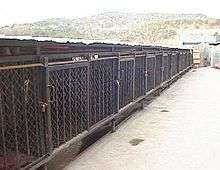
| Part of a series on |
| Animal rights |
|---|
|
|
Ideas |
|
Related |
|
|
The welfare of zoo animals varies widely. Many zoos work to improve their animal enclosures and make it fit the animals' needs, although constraints such as size and expense make it difficult to create ideal captive environments for many species.[52][53]
A study examining data collected over four decades found that polar bears, lions, tigers and cheetahs show evidence of stress in captivity.[54] Zoos can be internment camps for animals, but also a place of refuge. A zoo can be considered an internment camp due to the insufficient enclosures that the animals have to live in. When an elephant is placed in a pen that is flat, has no tree, no other elephants and only a few plastic toys to play with; it can lead to boredom and foot problems (Lemonic, McDowel, and Bjerklie 50). Also, animals can have a shorter life span when they are in these types of enclosures. Causes can be human diseases, materials in the cages, and possible escape attempts (Bendow 382). However, when zoos take time to think about the animal's welfare, zoos can become a place of refuge. There are animals that are injured in the wild and are unable to survive on their own, but in the zoos they can live out the rest of their lives healthy and happy (McGaffin). In recent years, some zoos have chosen to stop showing their larger animals because they are simply unable to provide an adequate enclosure for them (Lemonic, McDowell, and Bjerklie 50).
Moral concerns
Some critics and many animal rights activists argue that zoo animals are treated as voyeuristic objects, rather than living creatures, and often suffer due to the transition from being free and wild to captivity.[55] In the last 2 decades, European and North-American zoos, strongly depend on breeding within zoos, while decreasing the number of wild caught animals.
Behavioural restriction
Many modern zoos attempt to improve animal welfare by providing more space and behavioural enrichments. This often involves housing the animals in naturalistic enclosures that allow the animals to express some of their natural behaviours, such as roaming and foraging. However, many animals remain in barren concrete enclosures or other minimally enriched cages.[56]
Animals which naturally range over many km each day, or make seasonal migrations, are unable to perform these behaviors in zoo enclosures. For example, elephants usually travel approximately 45 km (28 mi) each day.[57]
Abnormal behaviour
Animals in zoos often exhibit behaviors that are abnormal in their frequency, intensity, or would not normally be part of their behavioural repertoire. These are usually indicative of stress.[58] For example, elephants sometimes perform head-bobbing, bears sometimes pace repeatedly around the limits of their enclosure, wild cats sometimes groom themselves obsessively, and birds pluck out their own feathers.[57] Some critics of zoos claim that the animals are always under physical and mental stress, regardless of the quality of care towards the animals.[59] Elephants have been recorded displaying stereotypical behaviours in the form of swaying back and forth, trunk swaying or route tracing. This has been observed in 54% of individuals in UK zoos.[60]
Shortened longevity
Elephants in Japanese zoos have shorter lifespans than their wild counterparts at only 17 years, although other studies suggest that zoo elephants live as long as those in the wild.[61] On the other hand, many other animals, such as reptiles, can live much longer than they would in the wild.
Climate concerns
Climatic conditions can make it difficult to keep some animals in zoos in some locations. For example, Alaska Zoo had an elephant named Maggie. She was housed in a small, indoor enclosure because the outdoor temperature was too low.[62][63]
Surplus animals
Especially in large animals, a limited number of spaces are available in zoos. As a consequence, various management tools are used to preserve the space for the most "valuable" individuals and reduce the risk of inbreeding. Management of animal populations is typically through international organizations such as AZA and EAZA.[64] Zoos have several different ways of managing the animal populations, such as moves between zoos, contraception, sale of excess animals and euthanization (culling).[65]
Contraception can be effective, but may also have health repercussions and can be difficult (or even impossible) to reverse in some animals.[66] Additionally, some species may lose their reproductive capability entirely if prevented from breeding for a period (whether through contraceptives or isolation), but further study is needed on the subject.[64] Sale of surplus animals from zoos was once common and in some cases animals have ended up in substandard facilities. In recent decades the practice of selling animals from certified zoos has declined.[65] A large number of animals are culled each year in zoos, but this is controversial.[67] A highly publicized culling as part of population management was that of a healthy giraffe at Copenhagen Zoo in 2014. The zoo argued that its genes already were well-represented in captivity, making the giraffe unsuitable for future breeding. There were offers to adopt it and an online petition to save it had many thousand signatories, but the culling proceeded.[68] Although zoos in some countries have been open about culling, the controversy of the subject and pressure from the public has resulted in others being closed.[65] This stands in contrast to most zoos publicly announcing animal births.[65] Furthermore, while many zoos are willing to cull smaller and/or low-profile animals, fewer are willing to do it with larger high-profile species.[65][67]
Live feeding and "baiting"
In many countries, feeding live vertebrates to zoo animals is illegal, except in exceptional circumstances. For example, some snakes refuse to eat dead prey. However, in the Badaltearing Safari Park in China, visitors can throw live goats into the lion enclosure and watch them being eaten, or can purchase live chickens tied to bamboo rods for the equivalent of 2 dollars/euros to dangle into lion pens. Visitors can drive through the lion compound in buses with specially designed chutes which they can use to push live chickens into the enclosure. In the Xiongsen Bear and Tiger Mountain Village near Guilin in south-east China, live cows and pigs are thrown to tigers to amuse visitors.[69]
Regulation
.jpg)
United States
In the United States, any public animal exhibit must be licensed and inspected by the Department of Agriculture, the Environmental Protection Agency, and the Occupational Safety and Health Administration. Depending on the animals they exhibit, the activities of zoos are regulated by laws including the Endangered Species Act, the Animal Welfare Act, the Migratory Bird Treaty Act of 1918 and others.[70]
Additionally, zoos in several countries may choose to pursue accreditation by the Association of Zoos and Aquariums (AZA), which originated in the U.S. To achieve accreditation, a zoo must pass an application and inspection process and meet or exceed the AZA's standards for animal health and welfare, fundraising, zoo staffing, and involvement in global conservation efforts. Inspection is performed by three experts (typically one veterinarian, one expert in animal care, and one expert in zoo management and operations) and then reviewed by a panel of twelve experts before accreditation is awarded. This accreditation process is repeated once every five years. The AZA estimates that there are approximately 2,400 animal exhibits operating under USDA license as of February 2007; fewer than 10% are accredited.[71]
Europe
The European Union introduced a directive to strengthen the conservation role of zoos, making it a statutory requirement that they participate in conservation and education, and requiring all member states to set up systems for their licensing and inspection.[72] Zoos are regulated in the UK by the Zoo Licensing Act of 1981, which came into effect in 1984. A zoo is defined as any "establishment where wild animals are kept for exhibition ... to which members of the public have access, with or without charge for admission, seven or more days in any period of twelve consecutive months", excluding circuses and pet shops. The Act requires that all zoos be inspected and licensed, and that animals kept in enclosures are provided with a suitable environment in which they can express most normal behavior.[72]
See also
- List of zoos
- Wildlife refuge
- List of zoo associations
- Animals in captivity
- Conservation
- Wildlife conservation
- Ex-situ conservation
- In-situ conservation
- Conservation movement
- Index of conservation articles
- Wildlife conservation
- Virtual zoo
- Extinction
- Endangered species
- Zoo emergency response team
- Zoology (includes a list of prominent zoologists)
- Immersion exhibit
- Frozen zoo
Notes
- "Landmarks in ZSL History", Zoological Society of London.
- "Visitor Demographics". Association of Zoos and Aquariums. Retrieved 7 July 2016.
- Blunt 1976; Reichenbach 2002, pp. 151–163.
- Hyson 2000, p. 29; Hyson 2003, pp. 1356-1357.
- Maple 1995, p. 25.
- Robinson 1987a, pp. 10-17; Robinson 1987b, pp. 678-682.
- Conway 1995, pp. 259-276.
- World's First Zoo - Hierakonpolis, Egypt, Archaeology Magazine, http://www.archaeology.org/1001/topten/egypt.html
- "Zoo". Encyclopædia Britannica. 24 March 2017.
- Lecky, W.E.H. History of European Morals from Augustus to Charlemagne. Vol. 1, Longmans, 1869, pp. 280-282.
- Blunt, Wilfred. The Ark in the Park: The Zoo in the Nineteenth Century. Hamish Hamilton, 1976, pp. 15-17.
- "Big cats prowled London's tower", BBC News, October 24, 2005.
- Martín del Campo y Sánchez, Rafael. "El parque zoológico de Moctezuma en Tenochtitlán" (PDF). Retrieved 9 August 2017.
- Brown, Tim (2014-01-01). "'Zoo proliferation'—The first British Zoos from 1831-1840". Der Zoologische Garten. 83 (1): 17–27. doi:10.1016/j.zoolgart.2014.05.002. ISSN 0044-5169.
in the years immediately after the establishment of the London Zoo, ... Britain had a number of these institutions when other countries did not have any or, at most, one such place
- "Introducing the Modern Zoo". Zoological Society of London. Archived from the original on 2013-12-14.
- "April 27". Today in Science History. Retrieved 5 March 2008.
- "ZSL's History". ZSL. Archived from the original on 28 February 2008. Retrieved 5 March 2008.
- "The Role of Architectural Design in Promoting the Social Objectives of Zoos". Retrieved 2012-12-17.
- Costello, John (June 9, 2011). "The great zoo's who". Irish Independent.
- Stewart, Herbert Leslie (29 December 2017). "The Dalhousie Review". Dalhousie University Press – via Google Books.
- McGregor, Phlis (4 September 2015). "Halifax's first zoo is well-kept secret of Fairmount history". CBC News.
- Punch, Terry (May–June 2006). "Zoo Diary". Saltscapes Magazine. Archived from the original on 28 February 2017.
- Rene S. Ebersole (November 2001). "The New Zoo". Audubon Magazine. National Audubon Society. Archived from the original on 2007-09-06. Retrieved 2007-12-18.
- See Kisling, Vernon N. (ed.): Zoo and Aquarium History, Boca Raton 2001. ISBN 0-8493-2100-X; Hoage, R. J. Deiss and William A. (ed.): New Worlds, New Animals, Washington 1996. ISBN 0-8018-5110-6; Hanson, Elizabeth. Animal Attractions, Princeton 2002. ISBN 0-691-05992-6; and Hancocks, David. A Different Nature, Berkeley 2001. ISBN 0-520-21879-5
- Donahue, Jesse and Trump, Erik. Political Animals: Public Art in American Zoos and Aquariums. Lexington Books, 2007, p. 79.
- Wielkie liczenie w zoo we Wrocławiu. Zobacz, ile zwierząt w nim mieszka
- Isler, Danuta. "A trip to Wroclaw Afrykarium". Radio Poland. Radio Poland. Archived from the original on 2018-07-13. Retrieved 2018-07-13.
- Masci, David. "Zoos in the 21st Century." CQ Researcher 28 Apr. 2000: 353-76. Web. 26 Jan. 2014.
- Bradford, Phillips Verner and Blume, Harvey. Ota Benga: The Pygmy in the Zoo. St. Martins Press, 1992.
- "Man and Monkey Show Disapproved by Clergy", The New York Times, September 10, 1906.
- Blanchard, Pascal; Bancel, Nicolas; and Lemaire, Sandrine. "From human zoos to colonial apotheoses: the era of exhibiting the Other" Archived April 18, 2008, at the Wayback Machine, Africultures.
- Ferral, Katelyn (2010-07-15). "N.C. Zoo, bucking a trend, sets an attendance record". Newsobserver.com. Archived from the original on 2013-05-09. Retrieved 2013-05-04.
- Guzoo Animal Farm Archived May 10, 2008, at the Wayback Machine, website about Canadian roadside zoos, accessed June 18, 2009.
- Roadside zoo animals starving. Free Lance-Star. 11 Jan. 1997.
- Dixon, Jennifer. House panel told of abuses by zoos. Times Daily. 8 July 1992.
- Elwood, Ian (8 April 2014). "Animal Abandonment is a Crime". Animal Legal Defense Fund. Archived from the original on 29 June 2017.
- "- APHIS Inspection Report of Cricket Hollow Zoo, May 21 2014".
- "Zoo: Procurement and care of animals," Encyclopædia Britannica, 2008.
- Tudge, Colin. Last Animals in the Zoo: How Mass Extinction Can Be Stopped, London 1991. ISBN 1-55963-157-0
- "Manifesto for Zoos" Archived August 23, 2006, at the Wayback Machine, John Regan Associates, 2004.
- "World Zoo and Aquarium Conservation Strategy" Archived 2007-02-16 at the Wayback Machine, World Association of Zoos and Aquariums.
- Brady, Leanna; Young, Richard; Goetz, Matthias; Dawson, Jeff (October 2017). "Increasing zoo's conservation potential through understanding barriers to holding globally threatened amphibians. Biodiversity and Conservation". CrossMark. 26 (11): 2736 (or 2). doi:10.1007/s10531-017-1384-y. ProQuest 1943858410.
- African Association of Zoological Gardens and Aquaria
- American Zoo and Aquarium Association and the Canadian Association of Zoos and Aquariums
- Australasian Regional Association of Zoological Parks and Aquaria Archived 2007-02-02 at the Wayback Machine
- European Association of Zoos and Aquaria
- Akpan, Nsikan. "Smithsonian's mystery of the black-crowned night herons solved by satellites". PBS News Hour. PBS. Retrieved 2 May 2016.
- "Birdworld Animals". Birdworld. Retrieved 21 January 2015.
- "Graureiher". Tiergarten Schoenbrunn. Retrieved 6 December 2014.
- Jensen, Derrick and Tweedy-Holmes Karen. Thought to exist in the wild: awakening from the nightmare of zoos. No Voice Unheard, 2007, p. 21; Baratay, Eric and Hardouin-Fugier, Elisabeth. Zoo: A History of the Zoological Gardens of the West. Reaktion, London. 2002.
- Goldston, Linda. February 11, 1999, cited in Scully, Matthew. Dominion. St. Martin's Griffin, 2004 (paperback), p. 64.
- Norton, Bryan G.; Hutchins, Michael; Stevens, Elizabeth F.; Maple, Terry L. (ed.): Ethics on the Ark. Zoos, Animal Welfare, and Wildlife Conservation. Washington, D.C., 1995. ISBN 1-56098-515-1
- Malmud, Randy. Reading Zoos. Representations of Animals and Captivity. New York, 1998. ISBN 0-8147-5602-6
- Derr, Mark. "Big Beasts, Tight Space and a Call for Change in Journal Report," The New York Times, October 2, 2003.
- Jensen, p. 48.
- Masci, D. (2000). "Zoos in the 21st century". CQ Researcher: 353–76. Archived from the original on 2015-04-02. Retrieved 2016-12-16.
- "Are Zoos good or bad for animals?". Archived from the original on 30 October 2013. Retrieved 28 October 2013.
- "The Perspective On Zoos". The Perspective. 27 September 2017. Retrieved 31 October 2017.
- Sterm, A. (28 February 2005). "Elephant deaths at zoos reignite animal debate: Zoo supporters cite conservation, activists cite confined spaces". MSNBC/Reuters. Retrieved 24 October 2012.
- Harris, M.; Sherwin, C.; Harris, S. (10 November 2008). "Defra Final Report on Elephant Welfare" (PDF). University of Bristol. Retrieved 16 November 2011.
- Mott, M. (11 December 2008). "Wild elephants live longer than their zoo counterparts". National Geographic News. Retrieved 24 October 2012.
- Kershaw, Sarah (10 January 2005). "Alaska's lone zoo elephant heats up national debate". Chicago Tribune. Retrieved 23 January 2016.
- Pemberton, Mary (11 January 2007). "Alaska's only elephant heads to California". NBC. Retrieved 23 January 2016.
- "Population Q&A". Zooquaria. EAZA. Autumn 2016 (94): 32–33.
- Kleiman, Thompson and Baer (2010). Wild Mammals in Captivity. pp. 265–266. ISBN 978-0-226-44009-5.
- Hunn, D. (February 16, 2014). "What happens when zoo contraceptives work too well?". St. Louis Dispatch. Retrieved November 21, 2016.
- "Marius The Giraffe Was Not Alone: Zoos in Europe Kill 5,000 Healthy Animals Annually". Huffington Post. February 27, 2014. Retrieved November 21, 2016.
- Johnston, I. (February 9, 2014). "Copenhagen Zoo kills 'surplus' young giraffe Marius despite online petition". The Independent. Retrieved February 10, 2014.
- "Ferocity training". Sunday Morning Post, Hong Kong. November 29, 1999.
- Grech, Kali S. "Overview of the Laws Affecting Zoos", Michigan State University College of Law, Animal Legal & Historical Center, 2004.
- AZA Accreditation Introduction Archived November 2, 2007, at the Wayback Machine
- "The Zoo Licensing Act 1981" Archived May 4, 2008, at the Wayback Machine, Department for Environment, Food, and Rural Affairs.
References
- Blunt, Wilfrid (1976). The Ark in the Park: The Zoo in the Nineteenth Century, Hamish Hamilton, London. ISBN 0-241-89331-3
- Braverman, Irus (2012). Zooland: The Institution of Captivity, Stanford University Press, Stanford. ISBN 9780804783576.
- Conway, William (1995). "The conservation park: A new zoo synthesis for a changed world", in The Ark Evolving: Zoos and Aquariums in Transition, Wemmer, Christen M. (ed.), Smithsonian Institution Conservation and Research Center, Front Royal, Virginia.
- Hyson, Jeffrey (2000). "Jungle of Eden: The Design of American Zoos" in Environmentalism in Landscape Architecture, Conan, Michel (ed.), Dumbarton Oaks, Washington. ISBN 0-88402-278-1
- Hyson, Jeffrey (2003). "Zoos," in Krech III, Shepard; Merchant, Carolyn; McNeill, John Robert, eds. (2004). Encyclopedia of World Environmental History. 3: O–Z, Index. Routledge. ISBN 978-0-415-93735-1.
- Maple, Terry (1995). "Toward a Responsible Zoo Agenda", in Ethics on the Ark: Zoos, Animal Welfare, and Wildlife Conservation, Norton, Bryan G., Hutchins, Michael, Stevens, Elizabeth F. and Maple, Terry L. (ed.), Smithsonian Institution Press, Washington. ISBN 1-56098-515-1
- Meuser, Natascha (2019). Zoo Buildings. Construction and Design Manual. DOM publishers, Berlin. ISBN 978-3-86922-680-4
- Reichenbach, Herman (2002). "Lost Menageries: Why and How Zoos Disappear (Part 1)", International Zoo News Vol.49/3 (No.316), April–May 2002.
- Robinson, Michael H. (1987a). "Beyond the zoo: The biopark", Defenders of Wildlife Magazine, Vol. 62, No. 6.
- Robinson, Michael H. (1987b). "Towards the Biopark: The Zoo That Is Not", American Association of Zoological Parks and Aquariums, Annual Proceedings.
External links
| Wikimedia Commons has media related to Zoos. |
| Look up zoo in Wiktionary, the free dictionary. |
- Zoos Worldwide Zoos, aquariums, animal sanctuaries and wildlife parks
- Zoological Gardens keeping Asian Elephants
- The Bartlett Society: Devoted to studying yesterday's methods of keeping wild animals, download page